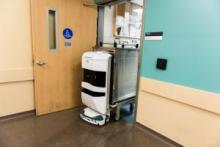Robots Roam UCSF’s New Hospital

Meet the Tugs — a team of 27 robots now zooming around the hallways of the new University of California San Francisco hospital at Mission Bay.
Instead of drones, think of them more as little flatbed trucks, ferrying carts of stuff around the vast hospital complex — food, linens, medications, medical waste and garbage. And they do it more efficiently than humans.
“This one is going up to one of the floors. It’s carrying meals that were ordered in probably the last 20 minutes,” said Dan Henroid, who is in charge of this elite fleet, as he pointed to a robot motoring by him.
Henroid, who is also director of nutrition and food services for the USCF Medical Center, says each Tug travels about 35 miles each day.
Not everyone in the hospital is such a big fan of the Tugs.
“I think they’re helpful. I think they’re also kind of a pain,” said Mardi Thompson, a nurse in the neonatal intensive care unit. “I’ve seen them run into computers; I’ve seen them run into glass doors; I’ve seen them run into each other.” Sometimes, she said, two Tugs get stuck near the nurses’ station, each one waiting for the other to pass. The nurses call that a “Tug of war.” She said over the past year, the robots have gotten better. But for Thompson, there’s still the issue of jobs.
“Definitely there are jobs lost, which is kind of interesting to me because with the economy the way it is, you’d think people need jobs. And then we have these robots doing them,” said Thompson.
Overall, the Tug program has cost UCSF about $6 million, including the changes required to hospital infrastructure to accommodate the robots. But Henroid said they have still saved the hospital money. “The cost of transporting materials and supplies waste is an overhead cost. So the more you can do you that efficiently, the less cost you have,” he explained.
About 120 hospitals throughout the U.S. are using Tugs, according to manufacturer Aethon in Pittsburgh, Pa.
The Tugs are kind of cute, but also a little unnerving, as they shuttle past other hospital workers like they own the joint. Each one is carefully programmed to stay out of the way, said Henroid, but sometimes it feels as if one could mow down a bystander.
The robots have very little contact with patients. They mostly stay in the hallways or nurses’ stations, where human workers pick up their goods and deliver them to patients in person. When the kids in the children’s hospital catch a glance, however, it’s quite a scene.
Medical-surgical unit coordinator Michael Eckenrode pointed out a half-dozen plastic toy vehicles nearby, including a cab and a bike.
The children like to climb aboard and ride them around the unit. “When the robots come the kids start screaming ‘Robots’ and they follow them down the hall. And it goes down around the corner and opens the elevator and gets on by itself. So that’s like a magic thing for them,” said Eckenrode.
Rogelio Diaz-Ramirez, an adorable three-year-old, was in the hospital with a lung infection, but he couldn’t stop smiling at just the thought of seeing a robot for the first time.
“We’re going to search for a robot!” said nurse Sonia Salinas in Spanish, as she took Rogelio’s hand and led him through the hallway.
Salinas spotted a Tug coming down the corridor. “Robot! Come on! Run, Run!” she told Rogelio.
Kaiser Health News is an editorially independent program of the Henry J. Kaiser Family Foundation, a nonprofit, nonpartisan health policy research and communication organization not affiliated with Kaiser Permanente.






